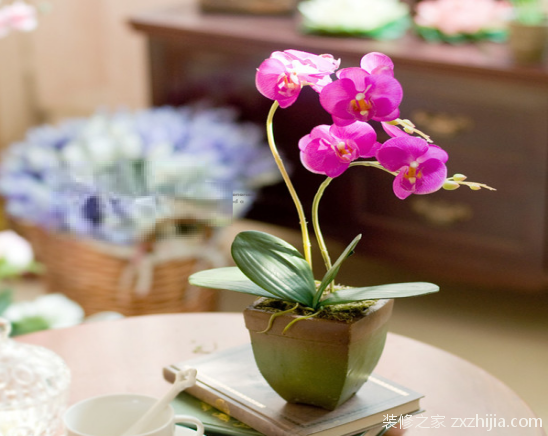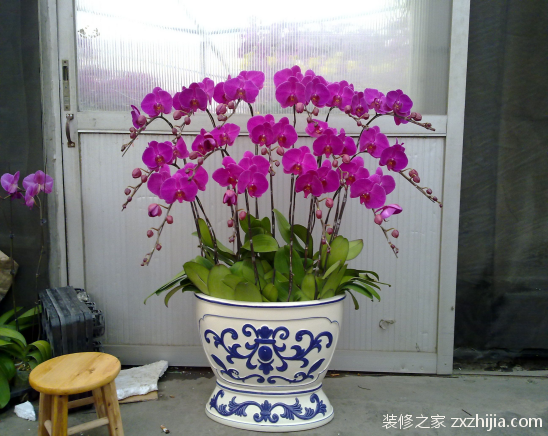Many people think that it is difficult to maintain the orchid in the northern environment because it feels that it needs a warm and humid environment. In fact, it does not mean that the butterfly orchid cannot be raised in the north. How can the butterfly orchid be raised ? The following decoration house decoration network Xiaobian will bring you the breeding methods and precautions of Phalaenopsis for your reference. How to raise phalaenopsis? Phalaenopsis culture method: 1, temperature: Family raising phalaenopsis must first ensure temperature. Phalaenopsis prefers a high temperature and high humidity environment. The minimum temperature during growth should be kept above 15 °C, and the suitable growth temperature of Phalaenopsis is 16-30 °C. At the turn of autumn and winter and winter and spring, and when the temperature in winter is low, you should pay attention to warming up. Generally, there is room for heating equipment in winter. This temperature is not difficult to achieve, but be careful not to place the flower directly on the radiator or too close. When the summer temperature is high, it needs to be cooled, and pay attention to ventilation. If the temperature is higher than 32 °C, the phalaenopsis will usually enter a semi-dormant state, and avoid high temperature. The flowering period is before and after the Spring Festival. Appropriate cooling can prolong the viewing time. The nighttime temperature during flowering is preferably controlled between 13 and 16 °C, but not lower than 13 °C. 2. Humidity: Phalaenopsis is native to the original forest, with more fog and higher temperature. Phalaenopsis does not have large fake bulbs to store nutrients. If the humidity in the air is insufficient, the leaves are wrinkled and weak. Therefore, Phalaenopsis should be cultivated and maintained in a well ventilated and humid environment. Phalaenopsis is suitable for growing air humidity of 60% to 80%. Phalaenopsis new roots should be watered during the prolonged period of vigorous growth, and watered less during the dormant period after flowering. Watering in the spring and autumn every day around 5 pm, the plants grow vigorously in summer, water is poured once every day at 9 am and 5 pm, the winter light is weak, the temperature is low, watering once every other week is enough, preferably at 10 am Before proceeding. In case of cold wave attack, it is not advisable to water, keep it dry, and then restore watering after the cold wave. 3, light: Although the phalaenopsis is more like yin, but still need to make the orchid plant can receive part of the light, especially before and after the flowering period, the appropriate light can promote the phalaenopsis flowering, make the flower blooms lasting, generally should be scattered indoors At the light, do not let the sun shine directly. 4, ventilation: the normal growth of Phalaenopsis requires fresh air, so the domestic butterfly orchid ventilation must be good, especially in the summer high-humidity period, must be well-ventilated to prevent heat, but also to avoid infection of pests and diseases. 5, fertilization: Phalaenopsis should be fertilized throughout the year, unless the low temperature lasts for a long time, it should not stop fat. In winter, during the flower bud differentiation period of Phalaenopsis, stopping the fertilizer can easily lead to no flowers or less flowers. During the spring and summer period, the thin liquid fertilizer can be applied every 7 to 10 days. It is advisable to use organic fertilizer, or apply special nutrient solution for Phalaenopsis, but do not apply when there are flower buds, otherwise it is easy to fall early. Summer long leaves (that is, after the flowering period), can be applied to nitrogen and potassium fertilizer. Phosphate fertilizer can be used in the growing season of autumn and winter flower stems, but it should be applied once every 2 to 3 weeks. 6. Cropping: The butterfly orchid period is generally around the Spring Festival, and the viewing period can be as long as 2 to 3 months. When the flowers are withered, the withered flowers must be cut off as early as possible to reduce nutrient consumption. If the stem is cut from the base 4 to 5 knots, it can be flowered again after 2 to 3 months. However, the nutrient consumption of such plants is too large, which is not conducive to the growth in the coming year. If you want to open a good flower again in the coming year, it is best to cut the flower stem from the base. When the matrix is ​​aging, it should be replaced at the right time. Otherwise, the gas permeability will be deteriorated, which will cause root decay and weaken or even die. Generally, it is advisable to change the pot in May when the new leaves are grown. Notes on the breeding of Phalaenopsis: 1. Watering over frequency: Friends who cultivate Phalaenopsis are always worried about the lack of water in Phalaenopsis, regardless of whether the cultivation medium is dry or not, watering every day, causing serious rotten roots. 2, the temperature is too low: Usually the phalaenopsis flowering plants are listed in the early spring, and they are generally placed in the living room after buying home. Although the daily temperature in these places is sufficient, the night temperature is slightly lower. On the other hand, most of the professionally cultivated orchids are in well-equipped greenhouses. In contrast, the temperature and humidity in the home are slightly insufficient, which makes the growth of plants tend to be weakened. Therefore, sometimes no matter how good the conservation, the orchid still does not bloom. 3, excessive fertilization: apply fertilizer, and do not pay attention to the concentration, I feel that the fertilizer will grow faster. It should be noted that the butterfly orchid should be applied with thin fertilizer. Remember that "tonic" can not be excessive, otherwise it is counterproductive. 4, small plants and large basins: I think that with large basins, you can give the Phalaenopsis a relaxed environment with plenty of materials. After its practical large basin, the water grass is not easy to dry, and it is necessary to know that the butterfly orchid is ventilated and the gas is comfortable. 5, dry flowers: Most of the current Phalaenopsis is urged to rush out, after leaving the base, the environment is likely to appear dry bags after the change, do not think it is dry, do not water more, but increase the indoor Humidity, control the temperature inside the room, the temperature can not be too high. When purchasing flowers, try to choose thicker petals. 6, common symptoms: Phalaenopsis susceptible to soft rot, gray spot disease. Soft rot is extremely contagious. Once the diseased plant is isolated, the diseased plant can be controlled by manganese citrate or good biosynthesis, usually once every 15 days. The common cultivation medium of Phalaenopsis is mainly water grass and moss. Therefore, potted plants should not use soil, but use water moss, pumice, swarf, charcoal and so on. The above is how the butterfly orchids brought to you by Xiaobian? The whole method of breeding methods and precautions of Phalaenopsis, I believe that everyone has a basic understanding of the breeding methods and precautions of Phalaenopsis after reading this article. If you want to know more about decoration consultation, please click to enter the decoration knowledge channel. . More related wonderful reading: How to raise the stars? The most comprehensive method of breeding How is carnation healthy? Carnation cultivation method Raiders How do you raise your anthurium? Anthurium farming methods and precautions How to raise potted jasmine? Potted jasmine culture method How to raise money grass? Method of breeding money grass Suitcase Bag,Tourister Bag,Monos Luggage,Small Suitcase LIYONG BAG , https://www.hoyo-bags.com
